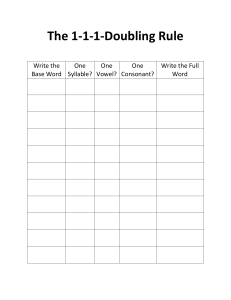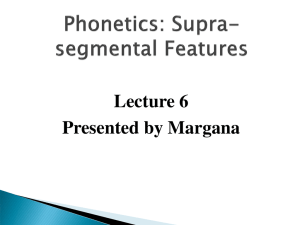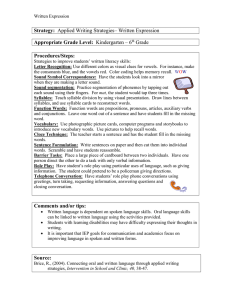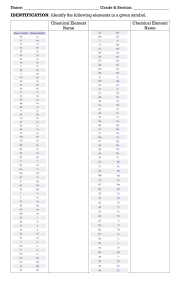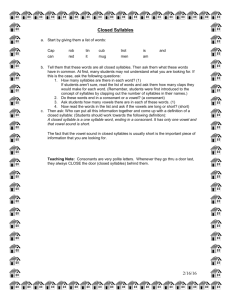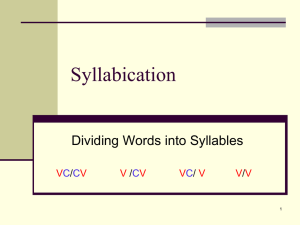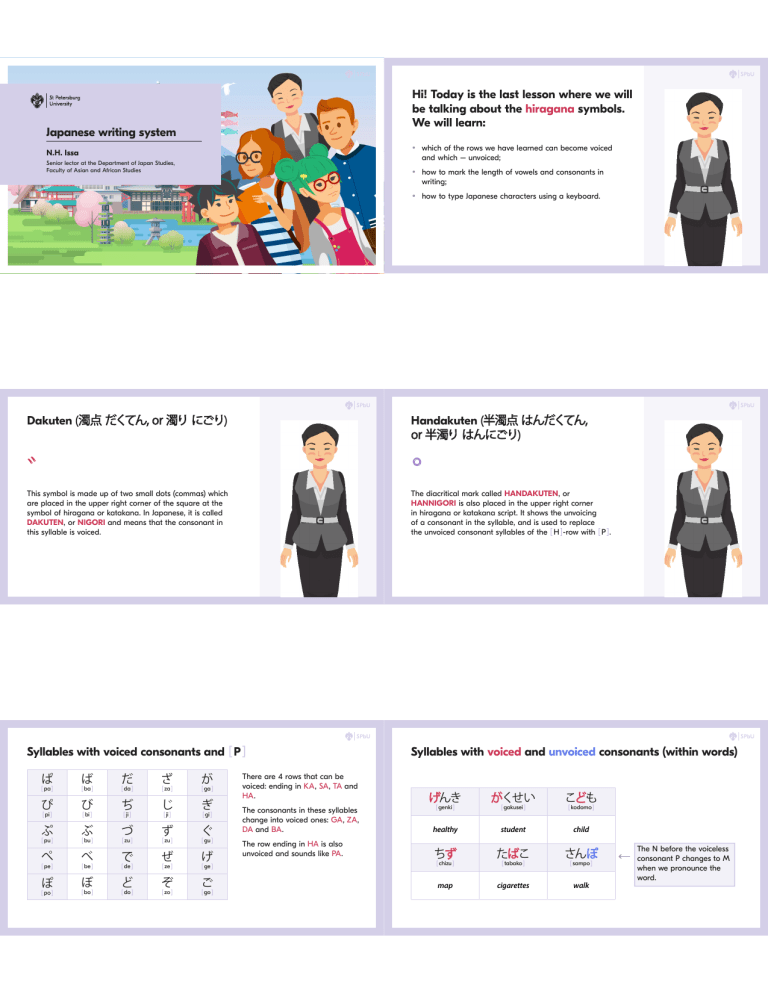
Hi! Today is the last lesson where we will be talking about the hiragana symbols. We will learn: Japanese writing system • which of the rows we have learned can become voiced and which – unvoiced; N.H. Issa Senior lector at the Department of Japan Studies, Faculty of Asian and African Studies • how to mark the length of vowels and consonants in writing; • how to type Japanese characters using a keyboard. Dakuten (濁点 だくてん, or 濁り にごり) Handakuten (半濁点 はんだくてん, or 半濁り はんにごり) ゛ ° The diacritical mark called HANDAKUTEN, or HANNIGORI is also placed in the upper right corner in hiragana or katakana script. It shows the unvoicing of a consonant in the syllable, and is used to replace the unvoiced consonant syllables of the [ H ]-row with [ P ]. This symbol is made up of two small dots (commas) which are placed in the upper right corner of the square at the symbol of hiragana or katakana. In Japanese, it is called DAKUTEN, or NIGORI and means that the consonant in this syllable is voiced. Syllables with voiced consonants and [ P ] [ pa ] ぱ [ bа ] [ dа ] だ ざ [ zа ] [ gа ] ぴ び ぢ じ ぎ ぷ ぶ づ ず ぐ [ pi ] [ pu ] ば [ bi ] [ bu ] [ ji ] [ zu ] [ ji ] [ zu ] が [ gi ] [ gu ] There are 4 rows that can be voiced: ending in KA, SA, TA and HA. The consonants in these syllables change into voiced ones: GA, ZA, DA and BA. The row ending in HA is also unvoiced and sounds like PA. Syllables with voiced and unvoiced consonants (within words) げんき がくせい こども healthy student child ちず たばこ さんぽ cigarettes walk [ genki ] ぺ べ で ぜ げ [ ge ] [ chizu ] ぽ ぼ ど ぞ ご map [ pe ] [ po ] [ be ] [ bo ] [ de ] [ do ] [ ze ] [ zo ] [ go ] [ gakusei ] [ tabako ] [ kodomo ] [ sampo ] The N before the voiceless consonant P changes to M when we pronounce the word. う – symbol denoting a vowel’s length In order to show that the vowels [U], [O] (including those which are within the syllables formed with [YU] or [YO]) are long, we use the symbol う [ U ] from the third row of hiragana. It is placed after the vowel that we want to make longer and is written in a separate square in full size. However, there might be some exceptions when it comes to the sound [ O ], when it is written with the letter お and other letters from the fifth line of the hiragana alphabet. In many words, which are etymologically not Chinese, we can find out many cases of the [ O ] prolonged with お. すうがく ありがとう つ – symbol denoting a consonant’s length けっこん れっしゃ [ ressha ] みっつ [ mittsu ] いっぱい [ su:gaku ] In order to make a consonant longer, we place the symbol つ [ TSU ] in front of it. It is also written in a separate square, but it does not occupy it completely, and is placed in the lower left corner. [ kekkon ] [ ippai ] For further information, please check the [ arigatо: ] additional materials. ん – symbol denoting a consonant’s length おんな [ onna ] はんのう [ hanno: ] In some Japanese words sound ん (we can roughly call it ‘nasal [ n ]’), when it comes together with the sounds [ n ] (regular ‘dental [ n ]’), and labial [ n ], makes these sounds longer. Syllables with iotized vowels In addition to voiced and unvoiced syllables in Japanese, there are syllables with soft consonants containing iotized vowels. In the table you will see that all the iotized vowels are attached to the second line of each row of the hiragana ending in the vowel I. りゃ みゃ ぴゃ ひゃ にょ ちゃ しゃ きゃ [ rya ] [ mya ] [ pya ] [ hya ] [ nya ] [ cha ] [ sha ] [ kya ] りゅ みゅ ぴゅ ひゅ にゅ ちゅ しゅ きゅ [ ryu ] [ myu ] [ pyu ] [ hyu ] [ nyu ] [ chu ] [ shu ] [ kyu ] りょ みょ ぴょ ひょ にょ ちょ しょ きょ [ ryo ] Positioning a syllable with an iotized vowel Iotized vowels are written in the lower left corner of a separate square in small size. If we take a look at the syllable GYA, we will see that the first square contains a full-sized symbol GI and the iotized vowel YA is placed in the second square. In case of voicing or unvoicing of the syllable, the diacritical symbol is placed in one square with the main syllable, and only then comes the iotized vowel. ぎ [ myo ] [ hyo ] [ nyo ] [ cho ] [ sho ] [ kyo ] Syllables with iotized vowels (words) ひゃく きょねん りょかん 100 last year Japanese-style hotel おちゃ でんしゃ ちゅうい green tea train attention [ hyaku ] [ ocha ] や [ pyo ] [ kyonen ] [ densha ] [ ryokan ] [ chu:i ] Typing syllables starting with voiced and unvoiced consonants: • [ К ] – Row Latin [ G ] • [ S ] – Row Latin [ J ], [ Z ] • [ D ] – Row Latin [ D ] • [ H ] – Row Latin [ B ] • [ H ] – Row Latin [ P ] Typing characters with iotized vowels じゃ にゅ ぎょ しゃ St Petersburg University [ JA ] [ NYU ] [ GYO ] [ SHA ]
